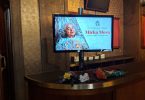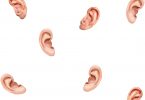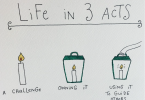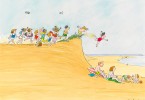
A WeTube LIVE cast member interpreting the popular Maru the Cat viral video series.
Beyoncé impersonators, makeup gurus and frustrated monologuists filled the Great Hall of the National Gallery of Victoria on Sunday afternoon as part of WeTube LIVE, a performance installation inspired by the popular video sharing site YouTube.
Directed by Ben Speth, WeTube LIVE featured 53 young people from around the Melbourne area performing interpretations of popular viral videos, using their own personal sound systems and props.
The performance was produced by Dance House for this year’s Dance Massive festival.
Sharing bits and bytes
Speth says that the idea behind the performance came from his own admitted “fascination and ambivalence” with “the dematerialisation of image” inherent in the move from physical film-based technologies to the digital medium.
“When YouTube was really coming on I was baffled and amazed at that technology… It existed as bits and bytes that were collected and rendered on a screen, but then just as easily disappeared, deleted,” he said.
According to YouTube’s own statistics, 72 hours of video are uploaded to YouTube every minute, and over four billion hours of video are watched on the website each month.
Speth says that the urge driving YouTube users to post videos is often the same urge driving the work of traditional artists.
“If I understand the compulsion of people who use YouTube, it is to say ‘here, this is what I’m interested in’… It’s really being an artist.”
“WeTube LIVE was an effort to rematerialise that, to put those efforts and that community, or that possibility for society, in a rematerialised setting, and to make it performative,” he said.

A WeTube LIVE cast member making paper cranes. Origami tutorial videos garner millions of views on YouTube.
Bringing people together
The cast of WeTube LIVE consisted entirely of young people from diverse backgrounds, reflecting the growing diversity of the online community.
“I thought it would be a fun experience, and an opportunity for me to meet new people,” said Thomas Banks, a WeTube LIVE performer who lives with cerebral palsy.
Banks’s performance consisted of interpretive dances to a variety of popular songs with videos that have gone viral on YouTube, including Same Love by Macklemore and Ryan Lewis.
Banks agrees that the cross-over point between YouTube videos and traditional arts is that both allow people to share something about themselves with others.
“It brings people together,” he said.
“It’s really important, more important because of my disability too, to be seen by people and for people to judge me for who I am.”
Banks says online entertainment is still not as good as the real thing, despite the popularity of video sharing,
“Performance is more intimate. People laugh more when it’s real-life theatre.”
Over to you – are viral videos an art form?
Could you see people one day celebrating our apparent goat obsession with the same respect given to Picasso or Vincent van Gogh?
Comment below to have your say!





